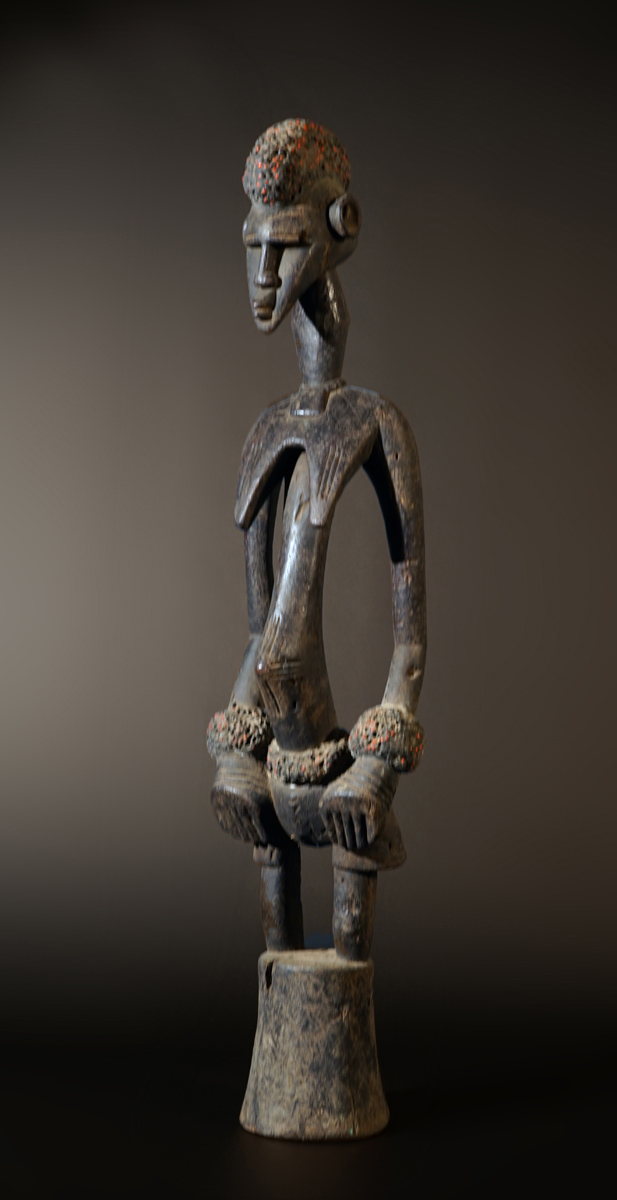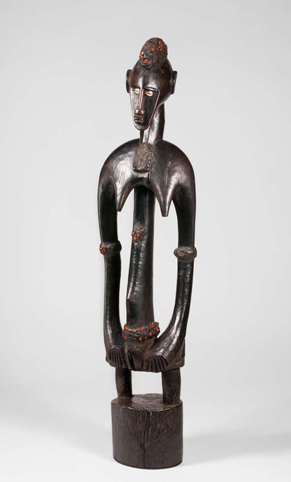|
A Senufo Rhythm Pounder,- called Déble - Ivory Coast, collected in the borderdestrict of Mali and Ivory Coast, the fe male statue upraising from a thick, cylindrical, slightly concave base with shortened legs, the openwork arms carved beside a slender torso with a protruding abdomen and a pointed navel, a short rhomboid neck supporting an ovoid head with a v-shaped fascial plane ending up in a pointed chin, semi-circular ears, a domed comb-like coiffure, the scarification signs and the hairdress are verifying this sculpture to the Northern style of Senufo country; natural dark patina, of heavy hard "Lenge" (Djula), "Fatier" wood (Senari) wood of dark colour, around the hips, the arms and on top of the figure remnants of reddish and blackened "pearls". signs of ritual use in particular at the arms and the cylindrical base, heavy hard wood, collected in the village...75 km North West of Korhogo. This type of sculptures - kown under the name deble - is one of the most famous works of West African Art. After the early 1960th, when the Massa-movement destroyed most of the important Senufo objects, only a few old, authentic Rhythm Pounder were saved and came to Western world. There are no sculptures from the time before 1960 existing anymore in the Senufo region of Ivory Coast, Burkina and Mali. But in some rural regions the old animistic tradition is still existing and also the funeral ceremonies, in which the deble rhythm pounder has it´s ritual function. There are differences in the ceremonies in comparison to the years before 1960. In particular the holy groves, doesn´t exist anymore or arn´t known by Western ethnologists. It were secret fields, where the Senufo placed their ritual sculptures in the forest.These precious objects would probably be stolen immediately, because in nearly every village the Islamic influence becomes stronger and there are more people, who are against the old animistic tradtiion than decades before. Now these objects are protected in huts close to the village. Homberger, Lorenz (Katalog) Die Kunst der Senufo aus Schweizer Sammlungen. Texte: Till Förster, Objektfotos: Wettsein+Kauf Zürich, Museum Rietberg, 1988, Koloss, Hans-Joachim; Förster, Till, Die Kunst der Senufo, Elfenbeinküste, 1979. Museum für Völkerkunde, Berlin, Burkhard Gottschalk Senoufo. Massa et les Statues du Poro, Düsseldorf: Verlag U. Gottschalk, 2002. sold Height: 108 cm |
 photo: wolfgang-jaenicke.com, for more information, please write us an e-mail with the identification number of the photo identification no. BSC00002.jpg |
